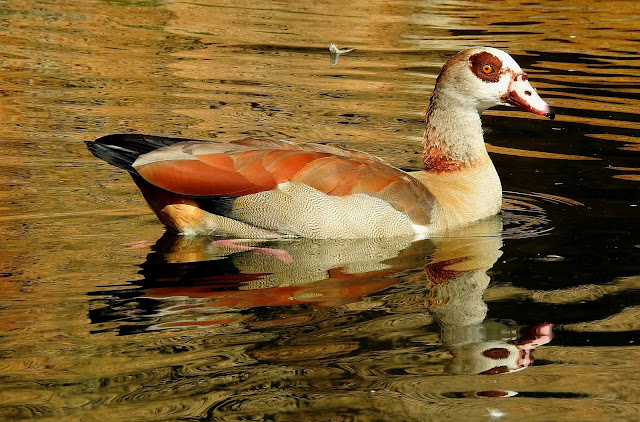
The Egyptian goose, Alopochen aegyptiaca, is a striking bird, native to Sub-Saharan Africa and the Nile Valley. It is a member of the Anatidae family, which includes ducks, geese, and swans. This species is unique in its appearance, resembling a goose more than a duck when in flight, with a heavy and robust stature. Adults typically measure between 63 to 73 centimeters in height.
Both sexes of the Egyptian goose display identical plumage, though males are generally larger. Plumage tones can vary from grey to brown, not necessarily indicative of age or sex. Mature birds boast a significant white patch on their wings, concealed by wing coverts when at rest but prominently displayed when the bird is agitated or in flight.
The Egyptian goose favors open or semi-open environments, often found near freshwater sources. Its habitat ranges from lowlands to high altitudes, such as the Ethiopian Highlands, up to 4,000 meters above sea level. It avoids dense forests and deserts.
This species is widespread and common in its native range, though numbers have dwindled in the northern Nile Valley. Historically found in southeastern Europe and parts of the Middle East, its presence in these areas has diminished.

The Egyptian goose is largely terrestrial, capable of perching on trees and buildings. It is known for its aggressive territorial behavior, especially during breeding season, and is not hesitant to engage in aerial combat with intruders. The species is monogamous, with both parents caring for their offspring.
The male's call is a subdued, hoarse quack, becoming louder and more rapid when agitated, resembling a steam engine. The female's quack is raucous and frequently heard, particularly when defending her young.
Nesting occurs in a variety of locations, with a preference for holes in mature trees. Both parents incubate the eggs, and the young are capable of foraging for themselves shortly after hatching.
Egyptian geese primarily consume seeds, leaves, grasses, and plant stems. They may also eat small animals such as locusts and worms. Goslings initially feed on small aquatic invertebrates before transitioning to grazing.
The Egyptian goose is classified as Least Concern by the IUCN, indicating a stable population. However, in regions where it has been introduced, it is considered invasive and may pose a threat to native species.












%2020.jpg)






















%2020.jpg)



